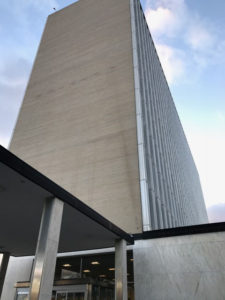This January 2017 was the Exoskeleton Technical Interchange Meeting. The meeting was co-hosted by the National Institute of Standards and Technology (NIST) and the U.S. Army NSRDEC. As planned, the event brought together over 150 participants from the industrial, military, and medical communities. In attendance were exoskeleton developers, representatives of the military, academia, medical providers, insurance providers, standards development organizations, and international organizations.
The event took place over two days and many of the discussion topics were to be expected but there were many surprises in the overarching themes of the Exoskeleton Technical Interchange Meeting:
- Standard Terminology
- It is one industry
- Community
- Communication
- Standards (for testing & reporting)
Standard Terminology
The first area of focus that spread over the entire meeting was the need for a standardized communication. Sometimes people are talking about the same thing using different terms, and other times people are using the same term but mean different things. Terminology needs to be cleaned up. Take a soft exosuit for example, it has no rigid external components yet it is still commonly referred to as a subtype of an exoskeleton. Even the name of the meeting was up for debate! The meeting could have just as easily been called Augmentation Technical Interchange Meeting or Wearable Robotics Technical Interchange Meeting. There is a “giant vocabulary that is not well defined.” A workgroup of volunteers has been created to start cleaning and standardizing the terminology and its progress will be reported at WearRAcon17 this April.
Think how difficult and annoying it is to try to describe or purchase something that is not clearly defined. For example, it turns out that a reactor top is called exactly the same at any of the major U.S. laboratory glass vendors. A 6 inch wide top with 3-port 20/40 with center 20/40 is the same piece of glassware at all major vendors. However, the bottom piece that the top closes off is not called the same everywhere. At one vendor it is a reactor, at another, it might be an evaporative flask and at a third a spherical container. Accounting for all of these variations just to look to purchase the glassware is hard enough, but it also interferes with bills of materials and equipment lists when generating documentation.
It is one industry
The Exoskeleton Technical Interchange Meeting purposely lumped all three major fields of the exoskeleton industry together. This was done deliberately to illustrate to everyone that the entire industry shares the same challenges and obstacles. There is a need to “come together as a community so we can build a better marketplace for all.”
This is aligned with views of ExR and WearRA regarding the industry too, for more on the latter, see Wearable Robotics Association Linking The Global Community. (Feb 2016)
As William Billotte of the NIST Special Programs Office explained there are two ways to create standards for the industry. The easy way is to work on the standards as a community verses in silos. The hard way is for each subfield to come up with its own terms and testing methods and then the three subfields will have to come together and realign.
Community

From the outside, the exoskeleton industry is viewed as one unified community. In particular, stakeholders who are not developers themselves expect that a type of exoskeleton should work the same, regardless of the manufacturer. A tool holding exoskeleton is expected to deliver similar performance no matter the maker. In addition, since few people can distinguish between exoskeleton producers, the success of one company will buoy the entire industry (and unfortunately vice versa).
But while the outside world perceives exoskeleton development as one unified process, this is not really the case. There is a lack of a positive feedback loop when it comes to developing people and ideas. Take the robotics field. A robotics company can have volunteers that help produce standards. Those standards can then be used to develop educational toolkits such as the Lego Mindstorm. These kits can then be used in robotics competitions that again use standards for terminology and judging criteria. This creates interest for kids and young adults and produces a new generation with hands-on experience in robotics. Upon graduation, these young people might work for robotics companies themselves or they will be much more likely to purchase robotics and automation solutions for their workplace. Whether it is because of its young age or limited funding, there aren’t many positive feedback loops or much of a community for exoskeleton technology.
Communication
At this point, it is clear that no single company has all of the solutions to commercialize wearable robotics and it is time to start pulling our efforts together. If the industry wants opportunities, members need to reach out and create them. This is done through direct communication. During the sessions, speaker after speaker lamented how no one had contacted them in advance to understand their needs or expectations before showing up with an exoskeleton on their footsteps (both figuratively and literally). We have the right people, but not the right relationships between stakeholders. For more see our first large Op-Ed piece from May 2016: Lack of communication is the greatest challenge to the exoskeleton industry.
Standards
There is a two-pronged need for standards in testing and reporting. First, businesses can’t buy exoskeletons at face value. Would you buy a digital camera if every single review came directly from the manufacturing company? Second, it is impossible to compare exoskeleton devices to one another if only best case scenario data is made public. For example, if one exoskeleton performs best at 4 miles/hour walking speed, and another performs best at 2 miles/hour, there isn’t enough information to understand how they will stack up against each other or estimate how they would perform at 1 mile/hour. For more on testing, you can read Business Importance Of Exoskeleton Independent Testing (Feb 2016) or a recap of the more recent presentation on Testing Wearable Robots. (Oct 2016)
What is being done?
The overarching themes of the Exoskeleton Technical Interchange Meeting is a to-do list for the entire exoskeleton industry. This is why events from last year like the WearRAcon16, Cybathlon, WeRob2016, the 2nd Annual Technology and Development Day, and The Exoskeleton Brokerage and Pitching Event have been so instrumental in laying the foundation for the future of the exoskeleton industry. The next time members of the exoskeleton technological field will get together will be this April at the upcoming WearRAcon17.








I am a paraplegic with a desperate drive to get involved in testing and rehabilitation thru exoskeleton technology , how can I go about becoming a part of some program where I can help test and at the same time reap the therapeutic benefits I so desperately need , plz contact me and hear my story , I feel that an exoskeleton may be my only hope for any kind of future and my story would show that this technology could open up a whole new workforce and a whole new genre of therapy , not just to maintain muscle density but to eventually build enough to function without the exo if possible , it’s amazing and freedom giving and life changing in ways u could not ever know .
Dear Eran, This was also discussed at the meeting. There are many people that have asked the same question both privately and online. The reality is that walking assist exoskeleton technology has not been made widely available. Unless you have about $100,000 laying around for an exoskeleton, service contract and training there are just a handful of options: 1st, you can look to see if there is a medical study in your area (easier said than done). 2nd, A handful of rehabilitation centers have exoskeletons and rehabilitation robotics implemented.